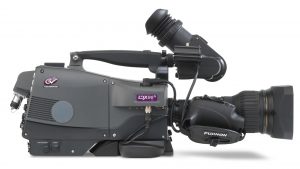SVG Europe Sit-Down: Grass Valley’s van Welsem discusses remote production, HDR and exciting AR/VR prospects
To better equip professionals for the demands of today’s market, Grass Valley provides cutting edge IP solutions based on open standards, as well as a wide range of 4K UHD capture and workflow solutions, including HDR in both 4K UHD and HD. And because Grass Valley offers fully integrated and bundled solutions throughout the broadcast ecosystem, easy implementation and future upgrades are readily available.
Our Sit Down with Jan-Pieter van Welsem, Vice President, Sales and Marketing, EMEA began with a look back at last year. Note: this interview was conducted prior to the recent announcement that Grass Valley will merge with SAM (Snell Advanced Media) following the latter’s acquisition by Belden. Clearly, only time will tell how the activities and operations of GV are affected by this merger.
Was 2017 a good year for Grass Valley? What milestones can you describe?
This was an exciting year for Grass Valley, a Belden Brand, with momentum building within the broadcast industry toward a transition to an IP future. Our goal of end-to-end IP broadcast solutions turned into reality and, as always, we are working hard to ensure that Grass Valley has the technology to adapt to our audience, who are looking for scalable, customizable solutions that help them meet their demands.

Jan-Pieter van Welsem, VP Sales and Marketing, EMEA
At the same time, we have seen much more interest in 4K UHD as well as HDR capture in 4K UHD and HD, and workflows for live production. The ability to deliver either more pixels with 4K UHD or better pixels with HDR makes it possible for broadcasters and content creators to choose what is right for them today while laying the groundwork for changing demands in the future.
Many of the products that we introduced during 2017 address the needs of our live production customers. For example, our solution portfolio now includes the LDX 86 Series camera platform with multiformat — HD/3G/4K UHD — and multispeed –1X/3X/6X — imaging. This advanced camera platform combines outstanding image performance, excellent light sensitivity and a software upgrade to enable 15 F-stops of HDR. In addition, the K2 Dyno Replay System is built to fit any broadcast space with the smallest footprint per channel of any 4K UHD replay solution; and the no-compromise K-Frame V-series switcher frame packed full of power and functionality delivers Grass Valley’s legendary reliability in only 3 RU and 62 pounds/28 kilos — ideal when space is at a premium and when you don’t want to compromise on features, regardless of budget. This switcher frame perfectly complements the compact GV Korona switcher panel available with 1, 2 or 3 M/Es.
Further expanding the industry-leading line of production switchers from Grass Valley, the new GV K-Frame X Video Processing Engine builds upon the power, performance and flexibility of the current K-Frame by providing customers the added versatility of all SDI, all IP, or mixed SDI and IP configurations.
What are the biggest challenges for 2018?
While 8K is certainly the next stop on the format roadmap, many broadcasters are still trying to decide how and when to make the leap to many of the 4K UHD and HDR technologies that have entered the market last year. As the pace of technology quickens, our market must plan for format agility.
With HD, providing the highest possible origination content was the rule and the formats were few and fixed. But today, resolution, colour space, luminance dynamic range and frame rate are all pushing their respective technology envelopes.
In this future, the highest quality would then be the highest level of performance for each one of these criteria. But, consumer electronics companies control this development unburdened from regulatory compliance throughout most of the world.
As long as there is a market need, each of these capabilities will rapidly increase until the point of diminishing returns for technology development. This creates a diverse environment where different formats, each with different levels of performance for each attribute, will co-exist based on market economics rather than regulatory compliance.
We are seeing an increasing number of sports broadcasts turning to remote production. How do you see the future of remote production impacting your business – and what developments can we expect?
Live remote productions have been a topic for quite some time, and the reasons are obvious — reducing the amount of equipment “on the road,” reducing staff travel time and keeping more staff in-house. In short, this can mean producing more live content with fewer resources. Grass Valley has been delivering different solutions for these applications for many years, but only the latest developments will allow producing remote productions more often.
Most of the remote production solutions used up until now require a great deal of dedicated and expensive hardware for converting, multiplexing and modulating multiple baseband signals onto IP interfaces. In addition, the set-up, management and control of these solutions is very complex and time consuming and can lead to unpredictable errors.
With the larger bandwidth IP networks available today, it’s becoming easier to produce live programming efficiently with multiple cameras across these networks. Our latest production cameras with their Direct IP functionality can be connected directly to commercial-off-the-shelf (COTS) switches on an IP network, transporting the full protocol of each camera through an IP network to the camera base stations connected to another COTS switch on the same IP network.
By facilitating the complete transmission protocol between the camera heads and camera base stations, remote productions can easily be realised without any trade off in image quality, signal latency or transmission stability. For some time now, Grass Valley has had installations based on this technology in use around the world every day.
For applications where large bandwidth IP networks are not available, new developments are becoming available where the video content inside the camera transmission protocol is compressed reducing the bandwidth requirements for a visible lossless image quality by the factor of 10. The introduction of compression allows realising remote productions at even more locations and, in combination with uncompressed Direct IP remote applications, they offer an attractive alternative to traditional OB productions. With our current product portfolio, we are able to deliver multiple solutions addressing the market requirements for more efficient OB productions.
How will the implementation of SMPTE 2110 impact your business in the coming months?
The publication of the SMPTE 2110 standard has been a major step forward in the industry for raw broadcast quality video, audio and ancilliary data over IP. We see a clear set of standards specifying the carriage, synchronisation and description of separate component streams over IP for the purposes of live production. This standard uses many of the concepts that underpin our work, and will ensure that there is interoperability between IP broadcast equipment from different vendors.
However, there is still much to do if we are to harness the benefits of end-to-end IP production to the maximum possible extent. We see a clear set of standards specifying the carriage, synchronisation and description of separate component streams over IP for the purposes of live production, and we continue to play a very active role in the establishment of standards that make it easy for our customers to protect their investments.
Our people contribute to the work of the standards bodies, and as a founding member of AIMS, we are working with other manufacturers to ensure interoperability across the production chain.
Has the move towards HDR been as you anticipated – and what are you doing to meet the needs of the sports market in this regards?
We have seen a more widespread interest in HDR over 4K UHD right now because it is easier to handle the workflow and viewers are immediately struck by the visual improvement on existing screens. However, for broadcasters and content creators, embracing an HDR workflow process raises a number of questions and poses some challenges.
Most notable is the need for a parallel SDR/HDR production workflow — one where the signal can be adapted with up/down mapping as required to mix and match incoming content formats and output signals without sacrificing quality. For example, operators may need to integrate existing SDR content into new HDR productions, or may need to send HDR content to SDR multiviewing screens in the studio. In either case, the producer’s intent for each individual signal must be maintained.
Grass Valley offers a portfolio of HDR-enabled solutions that includes cameras, switcher frames, servers, routers, up/down mapping cards and multiviewers. With these devices, broadcasters are able to produce native 10-bit HDR in either HD or 4K UHD and deliver that content in HDR and SDR simultaneously, as necessary, thanks to the high-quality conversion that can be done with a down mapping process. Additionally, these solutions provide native support for both of today’s worldwide standards: Hybrid-Log Gamma (HLG) and Perceptual Quantisation (PQ).
Virtual Reality and Augmented Reality are now ‘must have’ parts of sports production. How does Grass Valley meet these needs?
We’ve teamed up with manufacturer Mo-Sys to offer cutting edge AR and VR technology. We can provide a fully optimised solution by incorporating Mo-Sys’s industry-standard StarTracker tracking technology with the Grass Valley LDX Series Cameras.
Providing an integrated camera system to support live sports productions with augmented reality and

Mo-Sys’s StarTracker tracking technology is integrated with the Grass Valley LDX Series cameras
virtual sets removes the complexity of such applications and improves the business model for augmented content in live productions.
When making cutting-edge live augmented reality and virtual studio productions, the alignment between the camera and the tracking solution is vital. Any tolerance between these two elements will instantly break the fragile magic of virtual studio productions.
Mo-Sys turned the industry on its ear with the advent of StarTracker, by literally eliminating the “black art” formerly associated with camera tracking technology, thus single-handedly enhancing the industry’s acceptance of virtual studio solutions. Now, through its alliance with Grass Valley, another breakthrough is realised by putting tracking technology inside the camera. This significantly diminishes setup time and complexities by removing the need for bolt-ons and additional cables, as well as offset and weight considerations, making StarTracker ideal for SteadyCam and hand-held applications.

